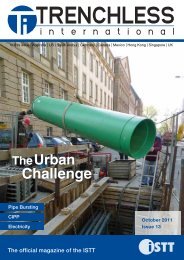North American Special - Trenchless International
North American Special - Trenchless International
North American Special - Trenchless International
You also want an ePaper? Increase the reach of your titles
YUMPU automatically turns print PDFs into web optimized ePapers that Google loves.
HDD is the key to the<br />
Keystone Pipeline<br />
by Lyndsie Mewett<br />
TransCanada is undertaking an innovative, cost-competitive way to accommodate the expected<br />
growth in Canadian crude oil production over the next decade. The Keystone Pipeline project is unique<br />
compared with other projects in that it combines both the construction of a new 2,219 km pipeline in<br />
the US and the conversion of an existing 864 km existing pipeline from natural gas to oil service. HDD<br />
is essential to preserve the stunning landscape and achieve the necessary river crossings.<br />
“The challenge for the<br />
Pembina River HDD is<br />
ensuring we protect the<br />
special features and the<br />
natural beauty of the area<br />
while getting the pipe in place<br />
to deliver oil.”<br />
north america<br />
April 2009 - <strong>Trenchless</strong> <strong>International</strong><br />
The 3,456 km Keystone Pipeline is also<br />
set to serve the interests of the United<br />
States by providing a secure and reliable<br />
supply of Canadian crude oil to meet<br />
the growing demand by US refineries<br />
and markets. TransCanada spokesperson<br />
Cecily Dobson says that the project is<br />
seen as an innovative and economic way<br />
to accommodate the expected growth in<br />
Canadian crude oil production during the<br />
next decade.<br />
Canada is the largest importer of crude<br />
oil to America, supplying 2.2 MMbbl/d.<br />
TransCanada has secured commitments<br />
for 910,000 bbl/d over an average term<br />
of 18 years for the Keystone Pipeline. Ms<br />
Dobson says that this represents 83 per<br />
cent of the system’s commercial design.<br />
Approximately 2,219 km of new pipeline<br />
is to be constructed in the United States.<br />
The Canadian portion of the project<br />
includes the construction of approximately<br />
373 km of new pipeline and the conversion<br />
of approximately 864 km of existing<br />
TransCanada pipeline from natural gas to<br />
crude oil transmission.<br />
HDD: protecting the environment<br />
The project crosses several large rivers,<br />
including the Mississippi, Missouri, South<br />
Saskatchewan and Red Deer rivers, using<br />
horizontal drilling technology.<br />
TransCanada spokesperson Terry<br />
Cunha outlined the details of one HDD<br />
The pipeline<br />
The pipeline is set to be 76 cm<br />
in diameter to Illinois and 91<br />
cm from the Nebraska/Kansas<br />
border to Cushing, Oklahoma.<br />
The pipeline will be buried with<br />
a minimum depth of cover of<br />
1.2 m, depending on land use.<br />
The estimated operating<br />
pressure of new pipeline<br />
sections will be 9,930 kPa. The<br />
existing pipeline proposed<br />
for conversion to crude oil<br />
transportation will be operated<br />
at its current approved<br />
allowable operating pressure of<br />
6,067 kPa.<br />
drive, the Pembina River crossing, west of<br />
Walhalla. The <strong>North</strong> Dakota State Forest<br />
Service acquired 432 acres of Pembina<br />
Gorge land in 1970 that now is Tetrault<br />
Woods State Forest. In May 2006, the<br />
Forest Service started to negotiate with<br />
representatives of Keystone Pipeline.<br />
The commission said TransCanada had<br />
to use HDD to bury the pipe in some<br />
locations, including parts of Pembina and<br />
Sargent counties. The technique will avoid<br />
the need to cut down trees in the Tetrault<br />
Woods state forest, and a Sheyenne River<br />
Valley scenic area in <strong>North</strong> Dakota's southeastern<br />
corner.<br />
In Pembina County, the crossing<br />
involved setting up a drill rig on the<br />
south side of the Pembina River. A 4 to<br />
6 inch diameter pilot hole was drilled at<br />
an inclined angle, 7 to 9 metres below the<br />
surface of the ground and river.<br />
Sections of pipe were then hooked to<br />
the drill head and pulled on rollers through<br />
the hole, under the river, to the other side<br />
a distance of 1,051 metres. Bentonite<br />
clay was used to fill the hole around the<br />
pipeline.<br />
The drive involved approximately 15<br />
workers in making the hole to feed the<br />
pipe under the Pembina Gorge.<br />
Mr Cunha said that similar to other<br />
HDD drives on the project, “the challenge<br />
for the Pembina River HDD is ensuring<br />
we protect the special features and the<br />
natural beauty of the area while getting the<br />
pipe in place to deliver oil.”<br />
Stakeholder involvement at length<br />
Not only is the Keystone Pipeline project<br />
unique in the fact that it involves the conversion<br />
of an existing pipeline, but the<br />
project's length means that it is being<br />
overseen by various provincial, state and<br />
federal regulators in both Canada and the<br />
United States.<br />
Ms Dobson says that a comprehensive<br />
stakeholder engagement program, developed<br />
and adapted to specific stakeholder<br />
needs according to the nature, location<br />
and potential effects, has been implemented.<br />
Stakeholders include landowners and<br />
residents; community leaders; federal,<br />
provincial and local elected representatives;<br />
aboriginal and Native <strong>American</strong><br />
stakeholders; regulatory agencies; emergency<br />
services organisations; special<br />
interest groups; and, co-located right of<br />
way owners.<br />
“We recognise the importance of incorporating<br />
public input into our project<br />
plans,” says Ms Dobson. “We believe<br />
that through consultation we can address<br />
questions and concerns, and integrate<br />
important public input into our activities.<br />
“We share project information and<br />
gather input throughout the planning<br />
phase and incorporate feedback into our<br />
project design and implementation as<br />
appropriate,” she says.<br />
Converting to oil<br />
Converting the existing facilities and<br />
constructing new facilities in Canada,<br />
<strong>North</strong> Dakota and northern South Dakota<br />
began in 2008, while construction of<br />
new facilities in South Dakota, Nebraska,<br />
Kansas, Missouri and Illinois will begin<br />
this year.<br />
“It is estimated that more than 5,000<br />
individuals will have worked on the design<br />
and construction of the Keystone project<br />
by the time it’s been completed,” says Ms<br />
Dobson.<br />
Ms Dobson says that the first task of the<br />
converting of the natural gas pipeline to<br />
oil service was to isolate the natural gas<br />
pipeline from the other pipeline to which it<br />
was interconnected. Existing natural gas<br />
in the pipeline was transferred to other<br />
natural gas pipelines using a portable<br />
transfer compressor.<br />
According to Ms Dobson, the greatest<br />
challenge of the conversion was to<br />
separate the converted pipeline from the<br />
other gas pipelines in a safe manner while<br />
ensuring there was no impact to existing<br />
shippers.<br />
Once the pipeline has been purged of<br />
natural gas, it will be ready for the removal<br />
of drip tanks and tie-over assemblies.<br />
Following the isolation of the pipeline,<br />
an in-line inspection using a pigging tool<br />
will be completed to ensure the integrity<br />
Timeline<br />
of the pipeline and that it is ready for oil<br />
service.<br />
Overcoming challenges<br />
In addition to the challenge of the HDD<br />
crossing, Ms Dobson said the weather was<br />
also a factor to be overcome. The Keystone<br />
project experienced some extremely wet<br />
conditions during the 2008 construction<br />
season. In <strong>North</strong> Dakota, it was one of<br />
the wettest years recorded in history. Ms<br />
Dobson said that TransCanada was forced<br />
to extend the construction season later<br />
into the year and postpone clean up until<br />
2009.<br />
Keystone Wood River Pakota – expected to be in service in 2009<br />
Keystone Cushing – expected to be in service in 2010<br />
Keystone Gulf Coast – expected in be in service in 2011<br />
Keystone Steele City – expected to be in service 2012<br />
north america<br />
April 2009 - <strong>Trenchless</strong> <strong>International</strong><br />
66<br />
67
















